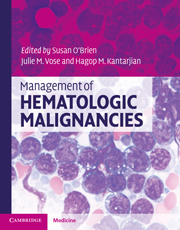Book contents
- Frontmatter
- Contents
- List of contributors
- 1 Molecular pathology of leukemia
- 2 Management of acute myeloid leukemia
- 3 Treatment of acute lymphoblastic leukemia (ALL) in adults
- 4 Chronic myeloid leukemia
- 5 Chronic lymphocytic leukemia/small lymphocytic lymphoma
- 6 Myelodysplastic syndromes (MDS)
- 7 Hairy cell leukemia
- 8 Acute promyelocytic leukemia: pathophysiology and clinical results update
- 9 Myeloproliferative neoplasms
- 10 Monoclonal gammopathy of undetermined significance, smoldering multiple myeloma, and multiple myeloma
- 11 Amyloidosis and other rare plasma cell dyscrasias
- 12 Waldenstrom's macroglobulinemia/lymphoplasmacytic lymphoma
- 13 WHO classification of lymphomas
- 14 Molecular pathology of lymphoma
- 15 International staging and response criteria for lymphomas
- 16 Treatment approach to diffuse large B-cell lymphomas
- 17 Mantle cell lymphoma
- 18 Follicular lymphomas
- 19 Hodgkin lymphoma: epidemiology, diagnosis, and treatment
- 20 Treatment approaches to MALT/marginal zone lymphoma
- 21 Peripheral T-cell lymphomas
- 22 Mycosis fungoides and Sézary syndrome
- 23 Central nervous system lymphoma
- 24 HIV-related lymphomas
- 25 Lymphoblastic lymphoma
- 26 Burkitt lymphoma
- Index
- References
23 - Central nervous system lymphoma
Published online by Cambridge University Press: 10 January 2011
- Frontmatter
- Contents
- List of contributors
- 1 Molecular pathology of leukemia
- 2 Management of acute myeloid leukemia
- 3 Treatment of acute lymphoblastic leukemia (ALL) in adults
- 4 Chronic myeloid leukemia
- 5 Chronic lymphocytic leukemia/small lymphocytic lymphoma
- 6 Myelodysplastic syndromes (MDS)
- 7 Hairy cell leukemia
- 8 Acute promyelocytic leukemia: pathophysiology and clinical results update
- 9 Myeloproliferative neoplasms
- 10 Monoclonal gammopathy of undetermined significance, smoldering multiple myeloma, and multiple myeloma
- 11 Amyloidosis and other rare plasma cell dyscrasias
- 12 Waldenstrom's macroglobulinemia/lymphoplasmacytic lymphoma
- 13 WHO classification of lymphomas
- 14 Molecular pathology of lymphoma
- 15 International staging and response criteria for lymphomas
- 16 Treatment approach to diffuse large B-cell lymphomas
- 17 Mantle cell lymphoma
- 18 Follicular lymphomas
- 19 Hodgkin lymphoma: epidemiology, diagnosis, and treatment
- 20 Treatment approaches to MALT/marginal zone lymphoma
- 21 Peripheral T-cell lymphomas
- 22 Mycosis fungoides and Sézary syndrome
- 23 Central nervous system lymphoma
- 24 HIV-related lymphomas
- 25 Lymphoblastic lymphoma
- 26 Burkitt lymphoma
- Index
- References
Summary
Introduction
Central nervous system (CNS) lymphoma may be isolated to the brain or leptomeninges in the absence of systemic disease (primary CNS lymphoma) or may occur as a neurologic complication of systemic lymphoma (secondary CNS lymphoma), usually in the form of leptomeningeal dissemination.
Primary CNS lymphoma
Primary central nervous system lymphoma (PCNSL) is an uncommon variant of extranodal non-Hodgkin lymphoma (NHL) that can affect multiple parts of the neuraxis including the eyes, brain, leptomeninges, or spinal cord. PCNSL accounts for approximately 3% of all the primary CNS tumors diagnosed each year in the United States and approximately 2–3% of all cases of NHL diagnosed each year. The incidence of PCNSL has increased over the past three decades, largely because of the human immunodeficiency virus (HIV) pandemic, but recent data suggest that the incidence has stabilized or is decreasing. Acquired or congenital immunodeficiency is the only established risk factor for PCNSL.
Since PCNSL is a rare malignancy, it has been challenging to study, which partially explains why it has been difficult to establish an effective standard of care for this type of lymphoma. In PCNSL, remission may be achieved for a few years but the tumor relapses in most cases. This chapter will focus on non-HIV-related CNS lymphoma since HIV-associated lymphomas are covered elsewhere.
Pathology and biology
Approximately 90% of non-HIV-associated PCNSL cases are diffuse large B-cell type with the remaining 10% consisting of poorly characterized low-grade lymphomas, Burkitt lymphomas, or T-cell lymphomas.
- Type
- Chapter
- Information
- Management of Hematologic Malignancies , pp. 449 - 461Publisher: Cambridge University PressPrint publication year: 2010



